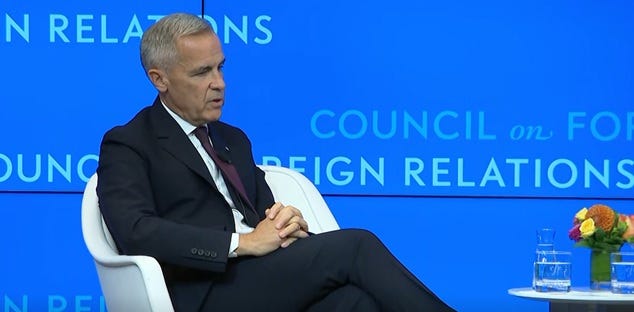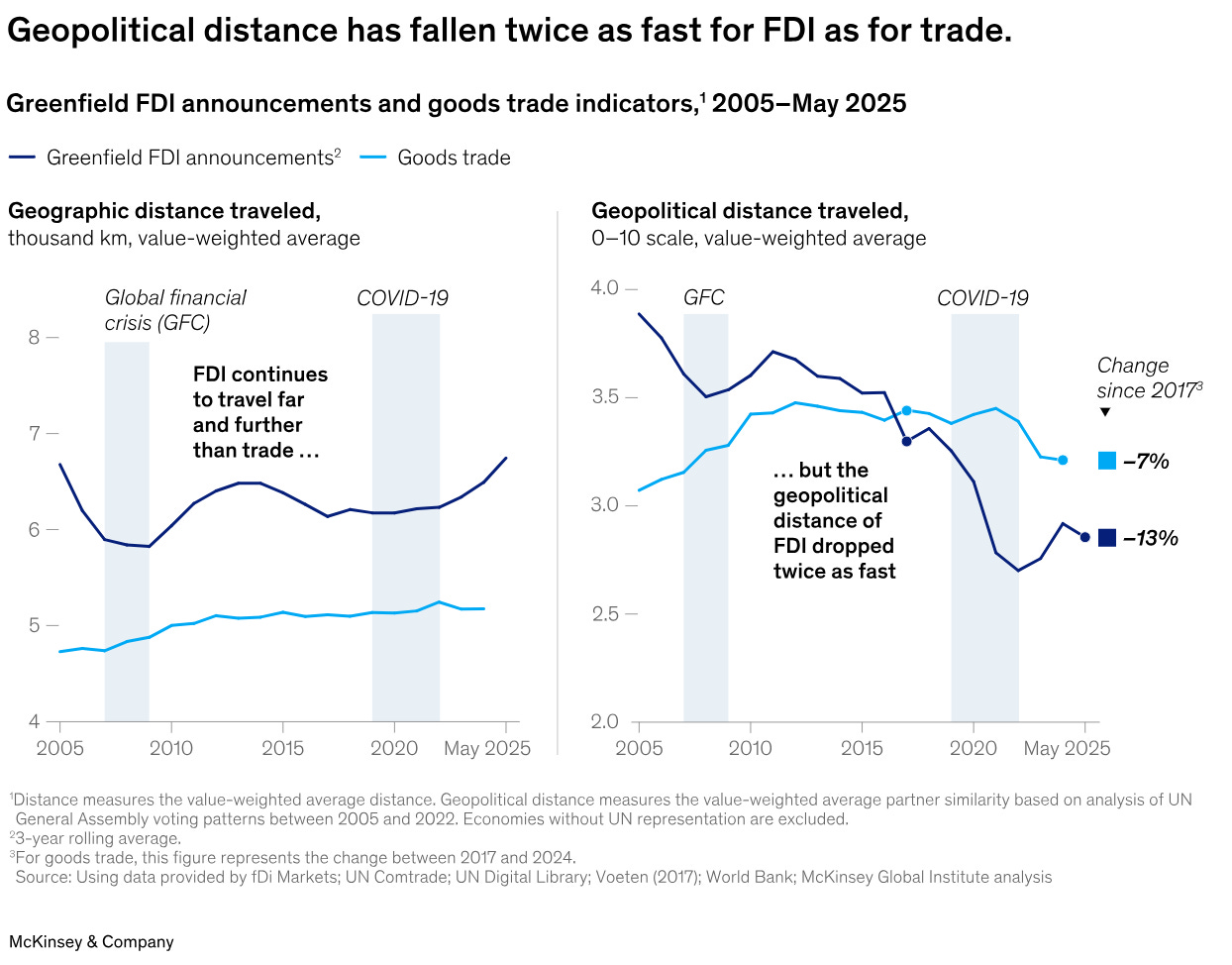Structural Deficits in Canadian Democracy
Or "Why the Ministry of Bloviation Only Gets You So Far"
Mark Carney took some time out of his UN duties in New York this past week to speak at the headquarters of the Council on Foreign Relations, seemingly talking his book (if his book is really Canada, after all), and appearing to proclaim on all the virtues of Canadian Democracy without too many jabs to the United States, in the context of ongoing trade disputes.
Part of his presentation and Q&A involved extolling the benefits of new defense, resource and housing “investments” - favorite euphemism of Liberal governments for decades now - while diminishing the long term risks of US trade isolationism. These are in abstract very good, very healthy, and very useful, but face categorical issues which he cannot, with his environmentally obsessed and economically dreadful caucus, address in any meaningful short term way in order to maintain enthusiasm for his mandate. Simultaneously, his election victory was dependent on a defective NDP voting for anyone but the conservatives: while demonizing conservatism is a tool of the trade, it will not sustain his coalition as macroeconomic enthusiasm continues to sour.
So, what are the short-run issues with Carney’s agenda?
Defense: By 2035, Canada will commit $125b per year to defense spending. Carney advertises this as dual-use, which implies that defense investments will also go to science & technology developments that lead to innovation and growth in the private economy. This is wonderful, fanciful, marvelous, but also an industrial development approach that takes 10-15 years to come to fruition, and the spending will only fully be realized 10 years from now, which means he is talking on a 25-year timeline - essentially when millennials will start retiring (lol).
Resources: Again, beholden to the environmental wing of his caucus, he cannot move too fast or too soon, which means that no resource investments will have an economic impact in the timeline of the Trump administration, and no leverage will be useful thereafter if the US economy continues to outgrow Canada at its current pace. The 5 major projects his government has selected are getting a “fast-track” approval process… of a maximum… of 2 years. This is even before they break ground. So much for Canada’s burgeoning resource sector - we’ll probably have another election before we hear anything new on this front.
Housing: In the CFR discussion, Carney touts a housing plan which scales to about $60 billion of housing investment. The official announcement references a scale of 45,000 homes. This implies a total cost of $1.3 million per home. This is for… modular homes? This is for technology that is supposed to be… cheaper than traditional homebuilding? As the adage goes, “If it was up to the NIH to cure polio, you’d have the best iron lung in the world… and no vaccine.”
Education, Entrepreneurship and AI: During the CFR event, Carney made light of the fact that Canadian universities produce an outsized amount of “AI talent”, however most of them end up working in the United States. At the same time, Canada imports an outsized number of high-skilled workers from overseas, substituting those that leave for the United States while diminishing the wage power of those remaining at home. Many Canadians who leave rarely want to return, while many who come to Canada find relatively low wages for the high cost of living, and basically leave with their savings after 10-15 years. This broadly undermines both capital and enterprise formation in Canada - investable entrepreneurs leave, and so does investable capital. 47% of Canada’s public pension scheme was invested in the United States as of the end of March 2025. This is advertised as a trade lever, when it should have never been a lever in the first place. CPPIB investments total $731 billion, which implies $350 billion invested abroad. An example of capital drought could be that the median Canadian venture rounds trail peers in the United States by 30-40% (with a statistical exception at Series B, due to the invariably smaller number of investments to measure…). The OECD average is probably about 30% diversified (best estimate available, a little old). This means that at least $125 billion could be reallocated to Canada - perhaps with some retaliatory consequences - but with a 3% return on capital (from a single pension fund, not all others), long run improvement could reach as much as .5% of GDP - which if applied on a per capita basis would lift Canada from the bottom to the middle of the OECD, already healthy progress. At the same time, the draw on Canadian talent to the south, and the desire of great foreign talent to leave when they get bored which likely both reduce, driving up the actual return and efficiency of capital that stays in Canada.
There is a little bit of wishful thinking in those numbers, surely. Economic integration has its benefits, and returns may well be higher in the US, but the actual behavior of the managerial class controlling Canada’s pocketbooks is essentially anti-nationalistic. Carney is an avatar of this class, who is he really to talk about Canada as investable if his peers won’t even make a move?
International Commitments (Ukraine & Palestine): Carney also spoke about how Canada is the largest contributor - on a per capita basis - to coalition efforts to support Ukraine. While this is again, virtuous and good-sounding on the surface, it ignores the fact that Canada is among the slowest-growing countries in the OECD - from a traditional Guns & Butter approach, it does not even have the Butter to buy Guns for someone else, which is inherently a nonproductive investment. One could make a Machiavellian argument that prolonging the war increases the value of Canadian resources while keeping Russia hostile to markets and internationally sanctioned, but without much new capacity developed in the last 25 years, how could that be at all beneficial to what will eventually become an adversarial arctic relationship?
As for Palestine, much has been made of Canada recognizing a Zionist two-state solution. Yes, Carney has even taken to the phrase “Zionist Palestine”, in an effort to please everyone and no one at the same time, but still appear to be doing something. This is again, while Canada is lagging economically, and doesn’t even invest domestically compared to peers. How can this be expected to be credible except when it is made to be for the willfully uninformed, and only create opposition to traditional allies in the US and Israel, while earning none in the broader Middle East, against whom Canada also competes to sell resources?
Structural Limitations of “Elbows Up”
It’s important to note that your elbows are also pointed up when your head is in the sand. The reality of the situation is that Canada is seeking to differentiate itself from the United States in a period where the distance travelled for both goods and investment will continue to decline.
source: https://www.mckinsey.com/mgi/our-research/the-fdi-shake-up-how-foreign-direct-investment-today-may-shape-industry-and-trade-tomorrow
Canada has to cross thousands of miles of ocean to get to its next closest trading partner, and the majority of its population lives within 50 miles of the United States. There is no exchange of trading partners there that does not simply reduce Canada’s productivity on transport costs alone.
At the same time, Canada’s manufacturing utilization (take it as a proxy for value-added). Is already significantly higher than the United States. This implies efficiency, surely, but it also implies that there is not supple opportunity for investment, and as utilization increases in the United States, new investments will also take off, making Canada even more uncompetitive - unless it fully integrates. In fact, it will be hard to keep pace with the United States, which is seeing a surge, while Mckinsey lumps the US and Canada together in a manner that essentially implies: there is no longer any point in tracking the difference.
source: https://tradingeconomics.com/canada/capacity-utilization
The point here is not to rag on Carney. I’m sure he does a good job when no urgency is involved and no consequences exist. The issue is that if Canada wants an actual opportunity to maintain sovereignty, significant gains need to be realized in 5 years or less. His predecessor already blew the bank on batteries nobody wanted and public service hiring that’s already being rolled back - if he can’t repatriate capital, drive investment in fixed capacity, fight back against the brain drain, remove barriers to private housing development and position Canada as a global minerals hub, there will basically be no economic will left to resist the United States when the Boomers die, even if that’s more than 25 years from now.




